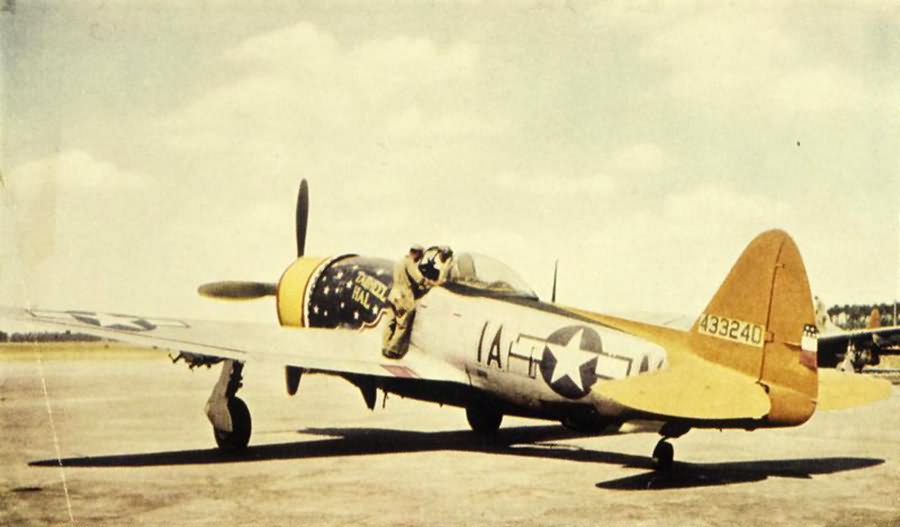The 358th Fighter Group (FG), also known as the “Orange Tails,” played a crucial role in the Allied air operations during World War II. Initially assigned to the 8th Air Force upon its arrival in England in October 1943, the 358th FG was transferred to the 9th Air Force on February 1, 1944. The Group was involved in a variety of missions ranging from bomber escort to close air support and ground attack operations.
Key Operations and History:
Arrival and Initial Missions:
- After completing its training in the United States, the 358th FG arrived in England in October 1943 and was initially assigned to the 8th Air Force. In February 1944, it was transferred to the 9th Air Force, where it began escorting heavy bombers of the 8th Air Force.
- In April 1944, the Group moved to an Advanced Landing Ground (ALG) in southern England and shifted to a fighter-bomber role. The 358th focused on attacking marshalling yards and airfields in France in preparation for the D-Day invasion.
D-Day and Beyond:
- On D-Day, June 6, 1944, the 358th FG was tasked with escorting C-47 transport planes over the Cotentin Peninsula. After completing this mission, the Group returned to its fighter-bomber role, conducting close-support and interdiction missions.
- In July 1944, the 358th moved to France, where it continued to fly escort missions and provide close air support for ground forces. The Group transferred to the 1st Tactical Air Force (TAF) control on November 15, 1944.
Distinguished Unit Citations (DUCs):
- The 358th FG earned its first DUC for its operations between December 24, 1944, and January 2, 1945. During this period, while operating from St. Dizier, the Group provided crucial support to the U.S. 7th Army and destroyed many Luftwaffe aircraft in assaults on Allied airfields.
- A second DUC was awarded for the Group’s actions in March 1945, during the German withdrawal across the Rhine. The 358th FG delivered devastating attacks on enemy forces and infrastructure, significantly hindering the German retreat.
- The third DUC was awarded for the Group’s performance in the final month of the war, particularly for its concentrated attacks on airfields in Bavaria and the destruction of the last remaining strategic targets.
End of the War and Return to the USA:
- After the victory in Europe, the 358th FG continued operations until it was returned to the United States in July 1945. The Group was subsequently inactivated later that year.
Organizational Details:
Squadrons and Codes:
- 365th Fighter Squadron (FS) [CH]
- 366th Fighter Squadron (FS) [IA]
- 367th Fighter Squadron (FS) [CP]
Bases:
- Raydon, Suffolk, England – January 31, 1944
- High Halden, Kent, England – April 13, 1944
- Cretteville, France – July 3, 1944
- Pontorson, France – August 14, 1944
- Vitry-le-François, France – September 15, 1944
- Mourmelon-le-Grand, France – October 16, 1944
- Toul, France – November 20, 1944
- Mannheim/Sandhofen, Germany – April 7, 1945
- Reims, France – June 23, 1945 – July 10, 1945
Commanding Officers:
- Col. Cecil L. Wells
- Col. James B. Tipton – September 20, 1944
- Lt. Col. John M. Thacker – 1945
Aircraft:
- P-47 Thunderbolt
Aircraft Markings:
Squadron Colors:
- 365th FS: White cowling, fin, and rudder.
- 366th FS: Yellow cowling, fin, and rudder.
- 367th FS: Red cowling, fin, and rudder.
Tactical Markings:
- In the latter part of 1944, the 358th FG adopted distinctive markings, which involved painting the entire rear tail section of their aircraft in a bright orange color, created by mixing equal parts of Insignia Red and White paint. This resulted in the Group being nicknamed the “Orange Tails.” The orange paint covered both the upper and lower horizontal tail surfaces, and often the aircraft canopy frames were similarly painted. The cowling was painted in the squadron’s respective color (white, yellow, or red), with some individual pilots adding personal touches to the cowling flaps.
Honors and Decorations:
Campaign Streamers:
- American Theater; Air Offensive, Europe; Normandy; Northern France; Rhineland; Ardennes-Alsace; Central Europe.
Unit Decorations:
- Distinguished Unit Citation: Ardennes, December 24, 1944, through January 2, 1945; March 19-20, 1945; Germany, April 8-25, 1945.
- French Croix de Guerre with Palm.
